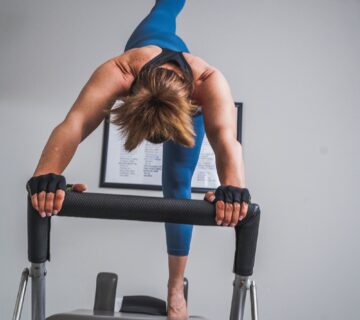Fascia has been enjoying the limelight in the fitness industry as one of the hottest topics in recent conference programming, workshops and publications. However, after the dust has settled, will fitness and wellness professionals still be scratching their heads and wondering, “Okay, great, it’s important, but what do I do with it?”
A great place to start is with the writings of Thomas Myers, whose April 2011 article in IDEA Fitness Journal titled “Fascial Fitness: Training in the Neuromyofascial Web” provides the fitness pro with an arsenal of research and ideas on how to train the fascial web. If that whets your appetite for further study, see Myers’s 2001 book Anatomy Trains: Myofascial Meridians for Manual and Movement Therapists (Churchill Livingstone 2001), which offers a unique perspective on the body’s internal design and has sparked research into fascia (or connective tissue) and its role in human movement and function.
This article offers eight key take-home points regarding fascia and fitness.
1. Myofascia Is a 3D Matrix
Fascia forms a whole-body, continuous three-dimensional matrix of structural support around our organs, muscles, joints, bones and nerve fibers. This multidirectional, multidimensional fascial arrangement also allows us to move in multiple directions (Myers 2001; Huijing 2003; Stecco 2009).
2. Fascia Is a Force Transmitter
Have you ever watched parkour athletes jump down from a two- or three-story building, tumble and smoothly transition into a run? How do their joints not explode on impact from the fall?
The answer is that internal force (from muscle) and external force (gravity and ground reaction) are transmitted and dispersed within the body primarily via the fascial network (so long as the force is not too great). Fascia helps prevent or minimize localized stress in a particular muscle, joint or bone, and it helps harness momentum created from the operating forces mainly through its viscoelastic properties. This protects the integrity of the body while minimizing the amount of fuel used during movement.
The myofascial lines depicted in Anatomy Trains give us a clearer picture of how the fascia mitigates stress—and force—through the body depending on the direction and application of force (Myers 2001; Huijing 2003; Sandercock & Maas 2009).
3. Repetition Is Good and Bad
Davis’s law states that soft tissue, a form of fascia, will remodel itself (becoming stiffer and denser) along lines of stress (Clark, Lucett & Corn 2008). This can have short-term benefits and long-term consequences. When we practice a movement repetitively, soft tissue will remodel itself in the direction of the desired movement so that the tissue becomes stronger at dealing with the forces in that particular direction. Long-term repetition can make fascia stiffer along the line of stress, but weaker in other directions, resulting in a possible higher frequency of tears in the fascia itself or immobility in the surrounding joints when moving in different directions. The same can be said of repetitive nonmovement, such as sitting or standing, for long periods across days, months and years.
4. Fascia Can Heal and Hypertrophy
A 1995 study demonstrates that mechanical stress (exercise) can induce hypertrophy of a ligament, a form of fascia (Fukuyama et al. 1995). New studies demonstrate the fascia system’s ability to heal itself after being torn. One such study found some people with anterior cruciate ligament (ACL) tears were able to return to full function without surgery and that the ACL healed completely (Matias et al. 2011). As we learn more, we may see new types of rehabilitation techniques, as well as changes in what we believe to be ideal form for some exercises.
5. Fascia Can Contract
Myofibroblasts, which allow smooth-muscle-like contractions to occur, have been found in fascia (Schleip et al. 2005). Numerous mechanoreceptors (Golgi tendon organs, Ruffini endings, Paciniform endings) have also been identified within the fascial matrix; these may be contributing to the smooth-muscle-like contractions and communicating with the central nervous system regarding the amount of shear forces within the connective tissue (Myers 2011). It is theorized that contraction of the fascia aids in stability and energy expenditure. More research is needed to understand how fascia and muscle contract in concert with one another, how these contractions affect overall movement and what they mean for the fitness professional.
6. Fascia Can Act Independently of the Central Nervous System
Fascia is always under tension as long as gravity is present. This passive pre-tension has been called human resting myofascial tone—which Myers discusses using the principle oftensegrity (Alfonse et al. 2010; Myers 2001). Resting myofascial tone provides a low-level stabilizing component that helps our posture and allows us to perform movements like getting in and out of a car without thinking about them.
Because connective tissue has 10 times more proprioceptors than muscle (Myers 2011), the fascial matrix helps us react to our environment faster than the conscious mind can respond, whether we are unexpectedly stepping off a curb, reacting to an opposing player in a sport or drawing a hand off a hot stove.
This pre-tension may also give us the ability to maintain posture with less fatigue and fascial strain as compared with constant muscle activation and energy expenditure. As an anecdote to this, a deconditioned client of mine commented on how she could stand and cook in the kitchen for 8 hours straight pain-free one Saturday, a task she could not have performed before her training. Could it be that her training had helped improve tensegrity and increase pre-tension through the fascia?
7. Mood Influences Fascia
In their book The Endless Web: Fascial Anatomy and Physical Reality (North Atlantic 1996), R. Louis Shultz and Rosemary Feitis discuss how our emotions are stored within the body, including the connective tissue.
“The physical response to emotion is through the soft tissue,” they write. “The fascia is the emotional body. . . . Ideally, feelings are felt in the total body—emotions travel through the fascial web. We then interpret the physiological sensation as anger, affection, love, interest and so forth. . . . The reason your neck can’t straighten and lengthen may be because of the shock of being continually bullied in childhood. Physical work will only partially open that problem unless there is recognition that there may be an emotional origin.”
Using this concept, the fitness professional can develop a holistic approach to understanding posture and movement—an approach that sees them, not just as physical, but as emotional and psychological as well. Fascia may become stiffer and less compliant when a client is depressed, anxious and fearful (Shultz & Feitis 1996; Lowe 1989). Trainers see this when clients show up after having a miserable day. Mood greatly influences posture, movement and proprioception. Perhaps enhancing mood may enhance the physical state through the fascial web.
8. Fascia Allows Us to Train the Body as a Whole
In Myers’s work, dissections demonstrated that connective tissue not only envelops muscle, bone and organs but does so continuously through many layers (Myers 2001). This link connects us holistically in movement and function. For athletes or others looking to improve or maximize function, the fascial web gives us a rationale for incorporating whole-body movements into our training regimens.
The more we learn about our connective tissue, the more we can integrate it with the other systems of the body (muscular, nervous, skeletal) and gain further insight into human movement and performance. Using myofascial lines in our training can give us a unique perspective on how to maximize our ability to mitigate force, save energy and build endurance while improving multijoint mobility and strength. Training the body as a whole in three dimensions, as opposed to training isolated, segmented parts, may be a missing link in the exercise programs of people looking to maintain or improve the integrity of their bodies.
Topics
References
Alfonse, M.T., et al. 2010. Clinical, biomechanical and physiological translational interpretations of human resting myofascial tone or tension. International Journal of Therapeutic Massage and Bodywork, 3 (4), 16–28.
Clark, M.A., Lucett, S.C., & Corn, R.J. 2008. NASM Essentials of Personal Fitness Training (3rd ed.). Baltimore: Lippincott Williams & Wilkins.
Fukuyama, S., et al. 1995. The effect of mechanical stress on hypertrophy of the lumbar ligamentum flavum. Journal of Spinal Disorders, 8 (2), 126–30.
Huijing, P.A. 2003. Muscular force transmission necessitates a multilevel integrative approach to the analysis of function of skeletal muscle. Exercise and Sports Sciences Review, 31 (4), 167–75.
Lowe, J. 1989. Myofascial genesis of unpleasant thoughts and emotions. Digest of Chiropractic Economics, 31 (5), 78–81.
Matias, C.-P., et al. 2011. Spontaneous healing in complete ACL ruptures: A clinical and MRI study. Clinical Orthopaedics and Related Research, doi: 10.1007/s1199-011-1933-8.
Myers, T.W. 2001. Anatomy Trains: Myofascial Meridians for Manual and Movement Therapists. New York: Churchill Livingstone.
Myers, T.W. 2011. Fascial fitness: Training in the neuromyofascial web. IDEA Fitness Journal, 8(4), 36–43.
Sandercock, T.G., & Maas, H. 2009. Force summation between muscles: Are muscles independent actuators? Medicine & Science in Sports & Exercise, 41 (1), 184–190.
Schleip R., et al. 2005. Active fascial contractility: Fascia may be able to contract in a smooth muscle-like manner and thereby influence musculoskeletal dynamics. Medical Hypothesis, 65(2), 273–77.
Shultz, R.L. & Feitis, R. 1996. The Endless Web: Fascial Anatomy and Physical Reality (pp. 46–50). Berkeley, CA: North Atlantic Books.
Stecco, C., et al. 2009. Mechanics of crural fascia: From anatomy to constitutive modelling.Surgical and Radiologic Anatomy, 31 ( 7), 523–29.
IDEA Mind-Body Wellness Review , Volume 1, Issue 1
© 2014 by IDEA Health & Fitness Inc. All rights reserved. Reproduction without permission is strictly prohibited.
Fit N Pilates is located in North Dallas in Plano at Preston and Plano Parkway. Sylvia Schepps is a certified in the Rolf method. Rolfing is a therapeutic approach to release the fasica and have it perform correctly.





